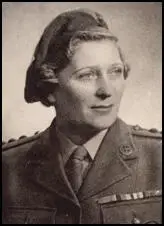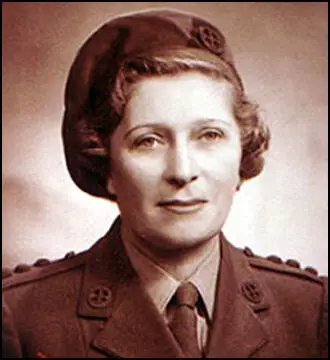Lise de Baissac

Lise de Baissac, the sister of Claude de Baissac, was born in Mauritius on 11th May, 1905. During the Second World War they both joined the Special Operations Executive (SOE).
Given the code name "Marguerite", Baissac and Andrée Borrel, became the first women agents to be was parachuted into France on 24th September 1942. They landed in the village of Boisrenard close to the town of Mer.
After staying with the French Resistance for a couple of days Baissac moved to Poiters whereas Borrel went to Paris to join the new Prosper Network. Over the next few months Baissac acted as liaison officer between the Prosper, Scientist and Bricklayer networks.
As she did not have a wireless she had to travel to Paris to send and receive messages and collect funds, or to Bordeaux where Claude de Baissac was building up the large circuit, organising sabotage and providing reports on submarines and shipping.
In June 1943, the Gestapo arrested several agents involved with the Prosper network including Andrée Borrel, Francis Suttill and Gilbert Norman, but Baissac managed to escape back to England.

Baissac was dropped back into France in April 1944, to work with the Pimento Circuit run by the SOE agent Anthony Brooks. However, she came into conflict with the group (she thought they were militant socialists with political aims) and joined her brother Claude de Baissac, who had gone to Normandy to reconnoitre large landing grounds that could be held for 48 hours while airborne troops established themselves.
A British army officer later claimed: “The part she played in aiding the Maquis and the British underground movement in France cannot be too highly stressed and did much to facilitate the Maquis preparations and resistance prior to the American breakthrough in Mayenne.” According to her Special Operations Executive file: “She was the inspiration of groups on the Orne and by her initiative caused heavy losses to the Germans with tyre bursters on the roads near St Aubin-le-Desert, St Mars, and as far as Laval, Le Mans and Rennes. She also took part in several armed attacks on enemy columns."
Baissac was awarded the MBE in September, 1945. After the war she married Henri Villameur, an artist and interior decorator living in Marseilles.
Lise de Baissac died aged 98 in Marseilles on 28th March, 2004.
Primary Sources
(1) Lise de Baissac, was interviewed by Rita Kramer for her book Flames in the Field, about being parachuted into France with Andrée Borrel on 24th September, 1942.
As it happens, we went twice. The pilot wouldn't drop us the first time because the lights on the landing field were not quite accurate, so we had to come all the way back, which was very trying. You were squashed in that little plane with a parachute on your back and your legs drawn up, and, of course, there was the danger too. Back in England they told us the reception committee had a man missing and so they couldn't place the lights for the signal the way they were supposed to.
We went back again the next night. We sat on the floor in the airplane, much too tense for conversation, which in any case was not possible because of the noise. I don't remember how long it was until the dispatcher opened the hole, which meant we were arriving. We crept nearer, getting our legs into position. We had drawn straws and luck gave Andree the first jump. I went immediately after her. You had to jump very quickly, one right after the other, because the plane is going on and you might be dropped very far from each other.
We didn't have to bury our parachutes or carry things or do anything. They did it all for us. There was very little talk, only what was essential. They took us in the moonlight to a shed in the woods nearby and we spent the rest of the night there. When the curfew ended in the morning they brought round a horse and cart and we climbed onto it and Culioli took us to the the place it had been arranged for us to stay for the next few days.
Andrée Borrel had been in France after the occupation started, but to me it was all new. I had never seen a German uniform, only the pictures they had shown us. The old people told us a lot of little things about everyday life, the regulations about identity cards, how to use ration tickets for food and clothes, which days different things were allowed or forbidden. We went out to look at the people, the different German uniforms. We went to the station to see the crowded trains and how they worked.
We talked about the war. We were not supposed to ask questions about our lives, past or present, and we kept to orders. I don't remember how it cropped up that Andrée had worked in a baker's shop on the Avenue Kleber and I realized it was the same bakery I used to go to every day to buy my bread. That
was the only thing I knew about her life before. She never mentioned her sister or her parents. I only knew her by her code name of Denise. But during those few days I appreciated her manner, her character. She was quick, determined, ready to face any situation. I liked her.
(2) Lise de Baissac, The Times (14th April, 2004)
De Baissac was one of the first two women agents to be parachuted into France on the night of April 24-25, 1942 - Yvonne Rudellat had arrived by boat two months earlier. She was dropped with the 22-year-old Andrée Borrell south of the Loire. Her mission was to establish a safe house in Poitiers where new agents could be settled into the secret life. Her cover story was that she was a widow, Madame Irene Brisse, seeking refuge from the tension of life in the capital. With characteristic nonchalance, she moved into an apartment on a busy street near the Gestapo HQ, and even became acquainted with the Gestapo chief - Grabowski - “hated by everyone”, she said. In Poitiers she made many friends, entertaining them at her flat, so agents visiting her would not seem unusual. She had presciently chosen a ground-floor apartment in a block without a concierge and even her cleaning lady, there every morning, never suspected her clandestine work. As well as receiving new agents, she organised reception committees for arms drops.

